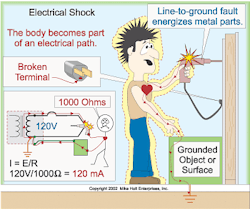Proper impedance paths are critical to shock prevention.
The National Safety Council estimates that nearly 300 people die in the United States each year from electric shocks on 120V or 277V circuits. Death occurs when voltage pushes electrons through the human body, particularly the heart. An electric shock from as little as 50VAC for as little as 1 sec can disrupt the heart's rhythm, causing death in a matter of minutes.
The severity of electric shock depends on the current flowing through the body, which is a function of the electromotive force (E) in volts, and the contact resistance (R) in ohms. Plug these values into the formula I=E÷R to find out how much current will flow through the body.
Electric shock can come in several forms, and the following descriptions apply to the various levels.
Electric sensation
Tingle sensation occurs at about 0.25mA to 0.5mA for an adult female and between 0.5mA and 1mA for an adult male.
Uncomfortable sensation
Current greater than 1mA to 2mA is very uncomfortable to either gender.
Maximum let-go level
The maximum let-go threshold level for a female is about 9mA and about 15mA for a male.
Fibrillation level
This is a function of current over time. For example, you will get fibrillation with 500mA over 0.2 sec or 75mA over 0.5 sec.
Let-go threshold
This is the current level at which humans lose muscle control; the electricity causes muscles to contract until current is removed.
According to IEEE Std. 80, you can determine the maximum safe shock duration by the formula, T=0.116÷(E÷R), where T is duration in seconds, E is the electromotive force in volts, and R is resistance of the person, which is a constant 1,000 ohms (see Figure).
For a 120V circuit, maximum shock duration=0.116÷(120V÷1,000)=1 sec
For a 277V circuit, maximum shock duration=0.116÷(277V÷1000)=0.43 sec
An overcurrent protection device (OCPD) protects against electric shock caused by a ground fault on metal parts of electric equipment. The time it takes for an OCPD to open, clear a ground fault, and remove dangerous voltage is inversely proportional to the magnitude of the fault current.
If the installation is in accordance with the NEC, an inverse time circuit breaker or fuse should quickly clear a ground fault, thereby removing dangerous touch voltage. However, the circuit must have a low-impedance ground-fault path that permits fault current of at least six times the rating of the OCPD. For a 20A circuit, the ground-fault current must be at least 120A to clear the fault quickly.
The impedance of the fault current path plays a critical role in removing dangerous voltages from metal parts and preventing electric shock by facilitating the opening of the branch-circuit overcurrent protection device. Be sure you don't take this path for granted. Terminate equipment-grounding conductors properly and make sure all mechanical connections are secure. One final tip: Only a GFCI can protect you from direct contact with an energized conductor.
About the Author

Mike Holt
Mike Holt is the owner of Mike Holt Enterprises (www.MikeHolt.com), one of the largest electrical publishers in the United States. He earned a master's degree in the Business Administration Program (MBA) from the University of Miami. He earned his reputation as a National Electrical Code (NEC) expert by working his way up through the electrical trade. Formally a construction editor for two different trade publications, Mike started his career as an apprentice electrician and eventually became a master electrician, an electrical inspector, a contractor, and an educator. Mike has taught more than 1,000 classes on 30 different electrical-related subjects — ranging from alarm installations to exam preparation and voltage drop calculations. He continues to produce seminars, videos, books, and online training for the trade as well as contribute monthly Code content to EC&M magazine.
